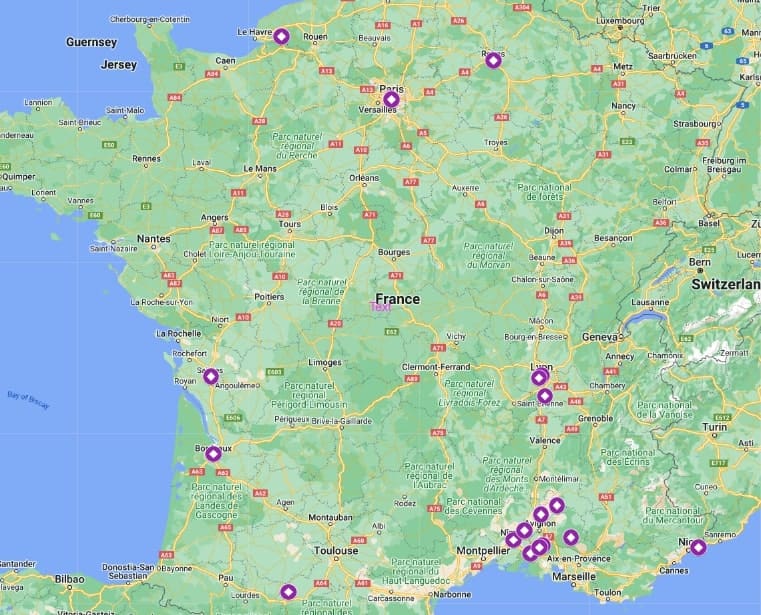Unsure about your French table manners? Click Here to download > > How to avoid these 10 food etiquette mistakes !
- Home ›
- Culture & Civilization of France ›
- Roman France
15 magical Ancient Roman Ruins in France
Updated 18 January 2022 by Leyla Alyanak — Parisian by birth, Lyonnaise by adoption, historian by passion
There are many Roman ruins in France, most of them concentrated in the southern half of the country. I've seen about half but I'm making it my mission to eventually visit them all!
If you've ever read Asterix, the French comic strip about an indomitable little Gallic village that bravely repels Roman forces ten times its size, you probably know most things you need to know about France's Roman past.
Gaul was the Roman name for France when it was a province of Rome because yes, we were not always as fiercely independent as we are today (apart from that little village where Asterix lived, of course).
The Romans didn't just pass by – they were here for more than 500 years and left all sorts of Roman ruins in France: amphorae, mosaics, soaring aqueducts and Roman bridges, as well as roads still used today, like the Via Domitia. They also left behind plenty of culture, not to mention Latin, the basis of our language.
NOTE: Pages on this site may contain affiliate links, which support this site. See full Privacy Policy here.
A quick history of Gallo-Roman France
When the Romans arrived, they found – rather than the baguettes or cafés they might have been led to expect – a mish-mash of warlike, druid-worshipping Celtic tribes, which they of course decided to invade and subdue.
There were two main Roman invasions. The first was around 120 BC or so, when Marseille was under siege by unfriendly attackers and called on Rome for help – which she willingly provided, establishing a large colony known as the Narbonnaise.
If you've visited this region, you'll understand why the Romans were not inclined to leave: beaches, snowy mountains, fertile land...
If you haven't read the Asterix comic books, now's your chance! This is a collection of three Asterix classics as the little Gaul celebrates his 60 years of defending his tiny village against none other than the legions of Julius Caesar! These tales are today intrinsic to French culture. BUY ON AMAZON
The second invasion came 50-60 years later and was spearheaded by none other than Julius Caesar, who stepped in to help 'protect' lands beyond the Rhine River from barbarian invasions.
This colonisation was a bit harsher, because strangely enough, the Gauls didn't actually want to be dominated by Rome. Never mind. At least the tribes finally began to unite under a common purpose: expelling the invader. Still, that would take a few centuries...
The Romans remained in France (who wouldn't, right?), spreading out into Aquitaine to the west, the Lyonnais region to the north, and Belgium even farther north. In 43 BC they founded Lyon (Lugdunum), which became the capital of Roman Gaul.
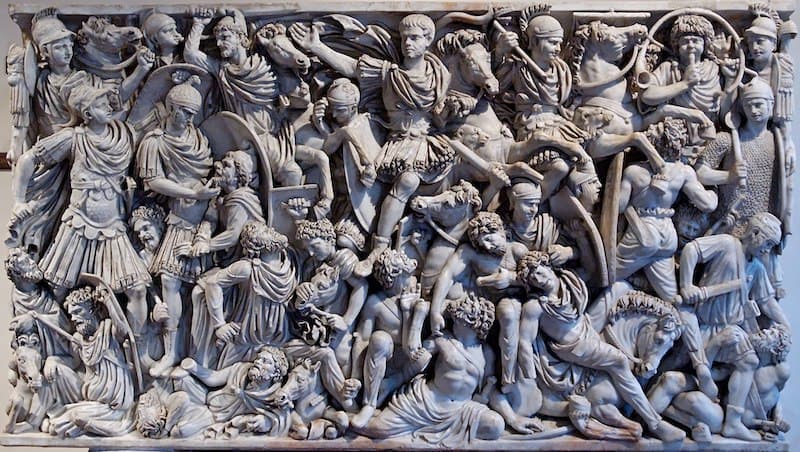 Since there was no photography in Roman times, we can get a good sense of these invasions from this ancient Roman sarcophagus of around 250 AD, which depicts a battle scene between the Romans and the invading Goths. It now sits in the Palazzo Altemps in Rome (part of the National Museum)
Since there was no photography in Roman times, we can get a good sense of these invasions from this ancient Roman sarcophagus of around 250 AD, which depicts a battle scene between the Romans and the invading Goths. It now sits in the Palazzo Altemps in Rome (part of the National Museum)This was a prosperous time and the Romans settled, building all the amphitheaters, arenas, triumphal arches and aqueducts we'll visit below. Eventually, 'barbarians', as the Germanic people from the north were called, would sweep in and wipe away as many traces of Rome as they could.
Granted, this potted history is all a little simplistic, given that this is a travel blog and not a history lesson. The Goths, for example, didn't exactly sweep in – but they trickled in over centuries, slowly insinuating themselves into society.
So if you need more information, I suggest you visit the Encyclopedia Britannica. Still, this bit of background should help us better understand the magnificence of what the Romans left behind, some of which I detail below.
For years, many of the areas we know as France, Belgium and Switzerland belonged to Rome, conquered by Julius Caesar. An extraordinary strategist, The Conquest of Gaul tells us how he did it – or, at least, how he SAYS he did it! BUY ON AMAZON
Where are the best Roman ruins in France?
Let's take a look at some of France's Roman ruins: we can't look at them all (here's a list) but here are some of the more exquisite and complete ones.
It should come as no surprise that most vestiges are in Roman Provence, in southern France, since this area was far closer to Rome as well as more densely populated than the more northern climes.
But Rome's tentacles did spread to Paris and well beyond, all the way to Scotland, although it is a logical fact that the farther from Rome you travel, the fewer Roman remains you'll encounter.
Roman ruins in Paris and northern France
Roman architecture in France is plentiful, but less so in the farthest reaches of the Roman Empire in Gaul. Still, there are some extraordinary Roman ruins near Paris (and IN Paris) that aren't too difficult to get to and worth the visit.
1. Arènes de Lutèce
Paris Roman ruins are relatively scarce for the city's size but the Arenes de Lutèce in the Latin Quarter are definitely among the most interesting and best-kept − and the oldest, if you don't count the obelisk on the Place de la Concorde, which was given to France by Egypt.
This arena was one of the public buildings of Lutèce, the Roman Paris. It was built in the first century AD and like most similar structures, it was a place of entertainment, hosting everything from theater plays to gladiator combats.
WHAT WERE GLADIATOR COMBATS?
These fights were a form of entertainment, like spectator sports today, and fights were often to the death, though by no means always. The fights were major events, announced on billboards and with much fanfare.
They had professional rules and a referee, and the best gladiators were celebrities. Some gladiators were volunteers, others were slaves or prisoners of war forced into the arena, but all underwent training.
Mostly, gladiators fought other men, not animals, although some animal fights existed (more slaughter than fight, really). Executions sometimes involved animals: the hapless condemned (criminals and, later, Christians) would be thrown into the arena and starving animals - usually dogs or lions - would be released.
Also, not all gladiators were men and women often fought - although they were slaves and compelled to do so.
This Roman arena in Paris was once far larger than it is now and in its heyday could accommodate up to 15,000 spectators, surpassed in size in France only by those of Nîmes and Arles (more about these below).
Elisa Subirats of World in Paris says you can choose one of two entrances, either through 47 rue Monge or through the rue des Arènes or Square Capitain. Or you can take a tour that includes the Arènes on its itinerary.
Only part of the original building remains. In fact, it was almost destroyed in the 19th century and replaced by a bus garage. It took wild protests by heavyweight Parisians, including writer Victor Hugo, for the city authorities to relent.
Eventually, the site was partly renovated and is now a public park. Like all Parisian parks, it is free.
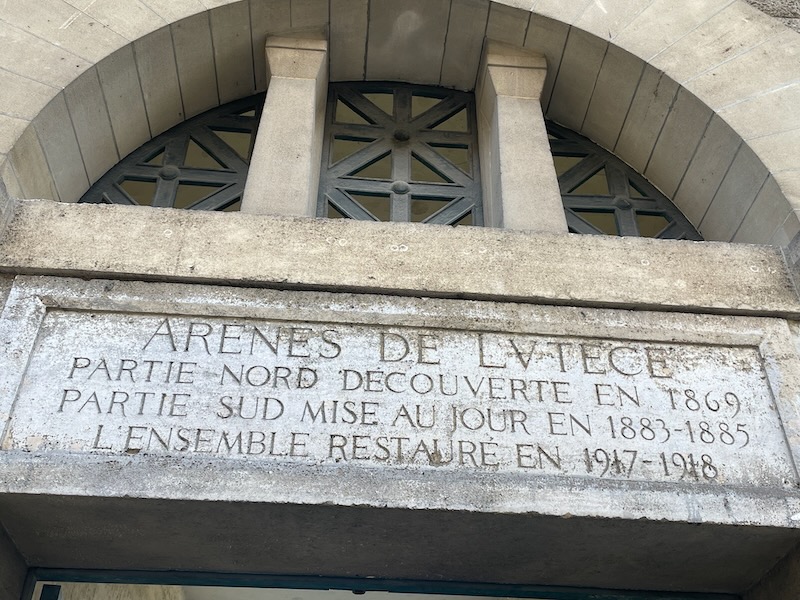 Entrance to the Arènes de Lutèce ©OffbeatFrance/Leyla Alyanak
Entrance to the Arènes de Lutèce ©OffbeatFrance/Leyla Alyanak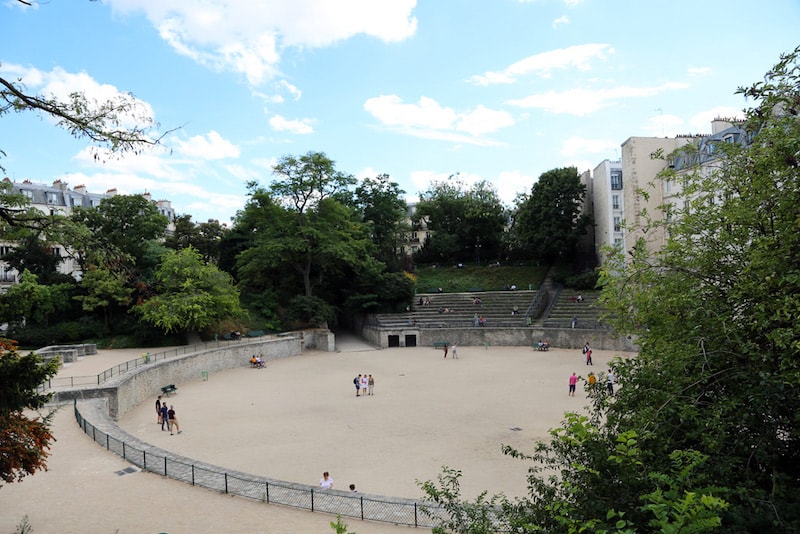 When it comes to Roman ruins, Paris cannot claim them in quantity - but it does have some quality vestiges: the Arènes de Lutèce is one, now a public park
When it comes to Roman ruins, Paris cannot claim them in quantity - but it does have some quality vestiges: the Arènes de Lutèce is one, now a public park2. Thermes de Cluny
Other than the Arènes de Lutèce, these are the most important Roman remains in Paris.
The baths are contemporaries of the arena and included a palestra for wrestling, after which one would of course seek rest and relaxation in the caldarium (hot baths), tepidarium (warm baths) and frigidarium (cold baths), the latter being the best-preserved of the ruins.
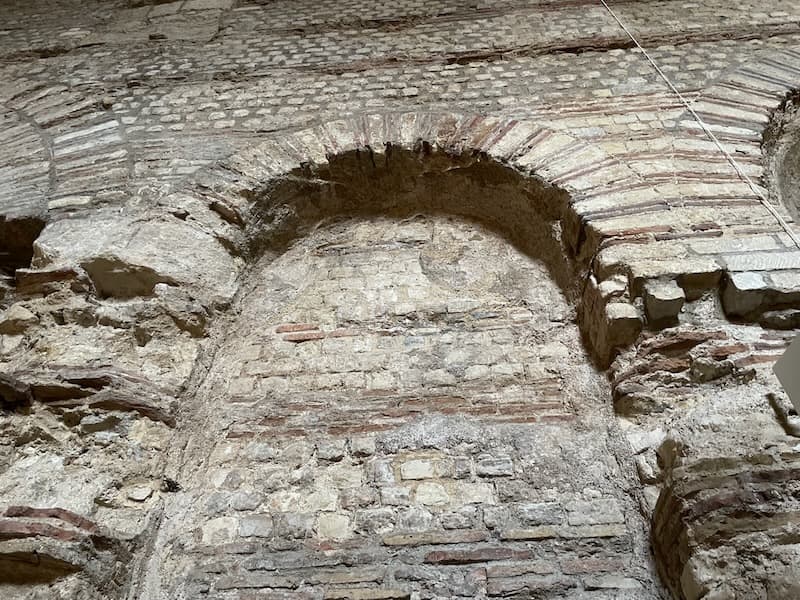
What's left of them have now been integrated into the National Museum of the Middle Ages, also known as the Cluny Museum.
3. La Porte de Mars, Reims
In a northern city known more for its champagne and Gothic cathedral than its Roman remnants sits the third-century Porte de Mars, also referred to as Mars Gate. It is the only standing gate of the four that once led into the city.
According to legend, Reims – or Durocortorum, as it was then called – was founded by Remus, brother of Romulus, founder of Rome.
At its height, Durocortorum had 30,000 inhabitants and was one of the most populated Gallo-Roman cities north of the Alps. It was also the capital of the Belgian Gaul province, hence the four gates.
The Porte de Mars has beautifully detailed and ornate carvings, particularly on the ceilings and exterior – they depict farm workers, Romulus and Remus, and Leda and the Swan.
Local history claims that the Porte de Mars was built to show gratitude toward the Roman Empire for building a large road passing through Reims.
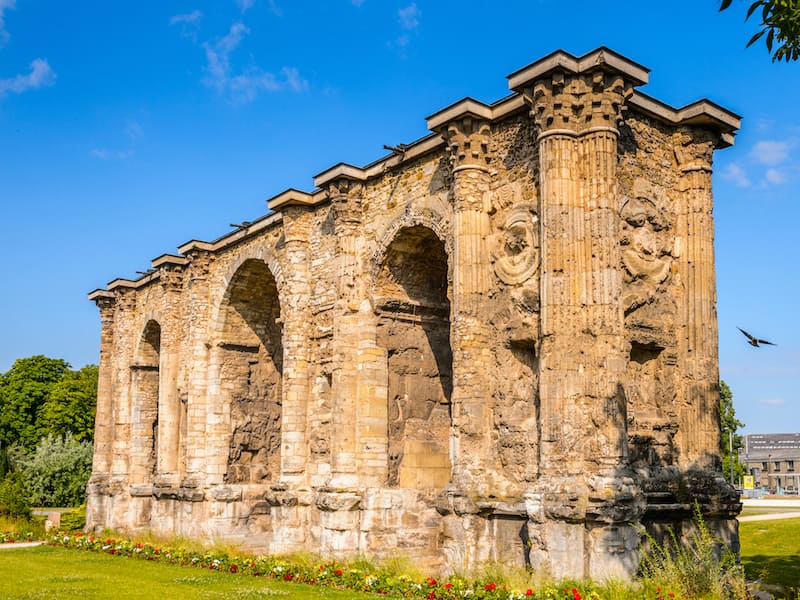 The Porte de Mars, in Reims - one of the more striking Roman monuments in France
The Porte de Mars, in Reims - one of the more striking Roman monuments in FranceAccording to blogger Megan Starr, visiting the Porte de Mars is one of the more unusual things to do in Reims; the Porte is central (near the cathedral and train station) and relatively easy to get to.
But, she warns, "It has undergone reconstructive and preservation efforts in recent years, so don't be shocked if it is under scaffolding or blocked off while these efforts take place."
The arch has three wide openings, each 32 meters long and 13 meters high, and was named after the God of War, Mars, whose temple once stood nearby.
Of course champagne and Roman ruins are not incompatible so if you have the time and inclination, take advantage of Reims to test a few of the bubblies...
Lyon Roman ruins and environs
4. Théâtre Gallo-Romain de Lyon Fourvière
It isn't surprising to find some outstanding Roman ruins in Lyon.
Remember, this was where many of Europe's Roman roads in France converged and was seen as extremely strategic. Lugdunum, as it was then known, grew and prospered commercially, not only because of its climate and fertile land but also because its location at the confluence of two major rivers, the Saône and the Rhône.
At its height, it was the empire's second largest city after Rome, with 50,000 inhabitants, the size of a modest provincial capital today.
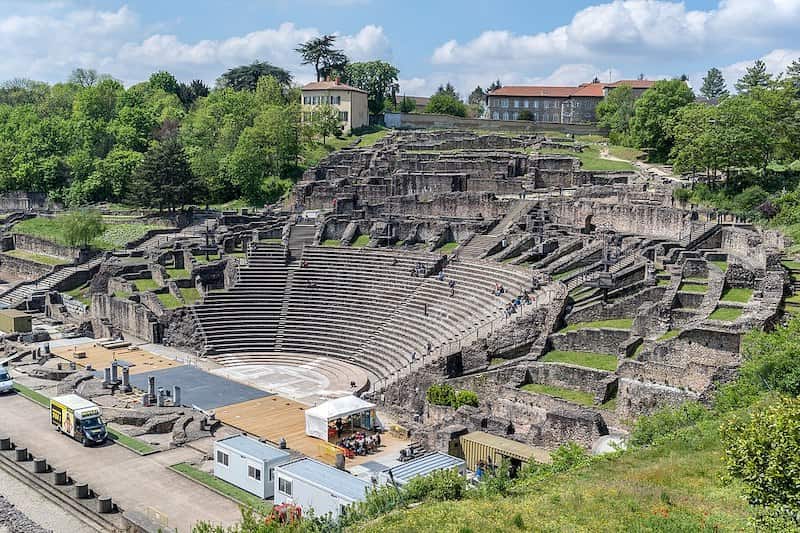 Roman ruins in Lyon: Lyon's ancient theatre of Fourvière (Photo by Jean-Christophe Benoist via CC By 4.0)
Roman ruins in Lyon: Lyon's ancient theatre of Fourvière (Photo by Jean-Christophe Benoist via CC By 4.0)You'll find France's oldest Gallo-Roman theater on Fourvière Hill, and when you visit, the excellent Lugdunum Museum puts it all into context.
IF YOU'RE STAYING IN LYON
➽ CLICK HERE to check hotel availability!
5. Aqueduc du Gier
If you'd like to visit some out-of-town ruins, not too far away is the impressive Aqueduc du Gier, thought to have been built during the first century AD.
At 85km, it is the longest of the four which carried water to Lugdunum, in this case from the Gier (a tributary of the Rhône). It is in fact one of the longest aqueducts ever built by Rome.
The Pont du Gard is more famous and taller, but the Aqueduct du Gier has far fewer visitors because the ruins are located along more than 20 different stretches before reaching Lyon.
According to Josh and Sarah of Veggie Vagabonds, "Tours are available or you can easily go and visit the ruins on your own at the likes of Mornant, Chaponost and Sainte-Foy-lès-Lyon on the outskirts of Lyon."
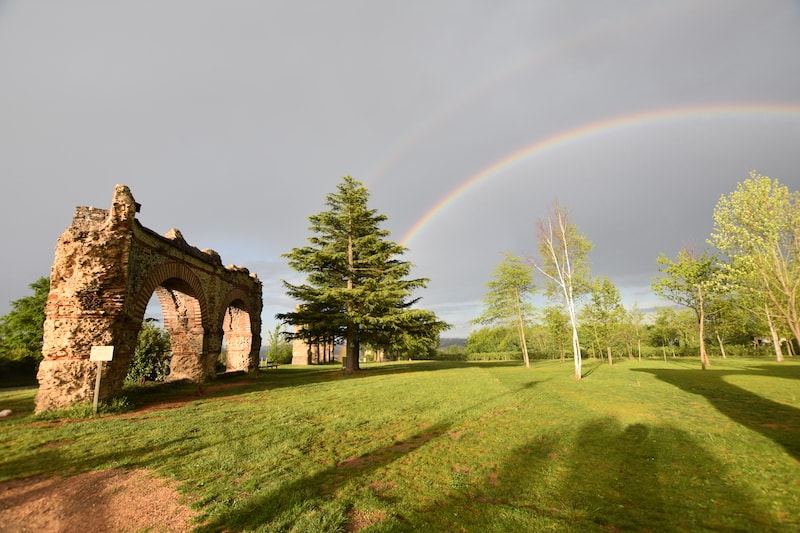 A wonderful example of Roman aqueducts in France - the Aqueduc du Gier
A wonderful example of Roman aqueducts in France - the Aqueduc du GierNeed your hands free to take pictures of all these wonderful French ruins? I use this wonderful infinity scarf by SHOLDIT: just put my car keys, ID and cards inside – no bag to carry, no backpack to hoist. GET A SHOLDIT!
6. Temple of Augustus and Livia
Half an hour south of Lyon is the city of Vienne, a major hub under the Romans, a sort of Rome in France. The importance of the city can be seen in its Roman ruins, of which the Temple of Augustus and Livia is a major example.
The temple, built around 25-27 AD, is dedicated to Emperor Augustus and his wife. Augustus was one of those emperors Rome likes to cite: he transformed it from a republic into an empire and restored peace in a troubled time.
Livia was herself a powerhouse, with multinational business holdings and high-level political entrées. She was also the mother of Tiberius, whom we shall meet again shortly.
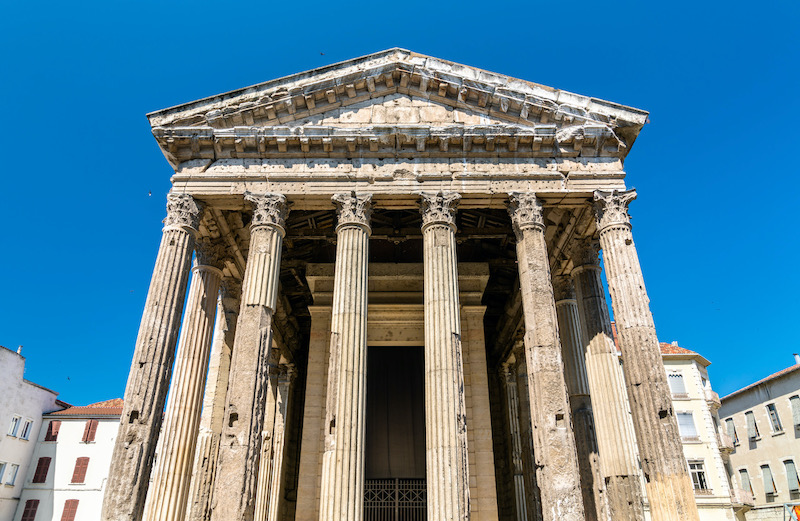 The Temple of Augustus and Livia in Vienne
The Temple of Augustus and Livia in VienneThis and the Maison Carrée in Nîmes are the only two six-columned temples in France. During its lifetime, it has been used as a church, a courthourse, and a library although it has remained relatively intact, perhaps because it actually served some useful functions.
Roman ruins in Provence
As we can see, the Romans did not neglect France's northern half and left plenty of ruins for us to enjoy.
While excellent, they are far more scattered than the ones you will find further south, where Roman ruins almost seem to bump into one another. So let's have a look at some of the best Roman ruins in southern France. (This south of France road trip is a great way to see many of these ruins.)
7. Théâtre antique d'Orange
Driving into Orange (called Arausio by the Romans) from the north, on the old Nationale 7 we used before the autoroutes were built, you will inevitably come face to face with one of the city's best-loved Roman monuments: the Arc de Triomphe, or triumphal arch, which stands right in the middle.
The road actually curves around the arch, but you cannot miss it, nor should you, with its superb sculptures of bygone battles and trophies.
The arch, by the way, was built by Emperor Augustus, Rome's first emperor, in honour of war veterans. It is, however, dedicated to his adopted son Tiberius.
Emperor Tiberius, although a capable military leader, turned into nasty tyrant in his later years and was much reviled. We must assume his father dedicated the arch to him before all this nastiness, or in a moment of parental blindness.
Once you've observed the arch from every angle, get yourself to the old town and wander into France's first (and Europe's best-preserved) Roman theater, which is included on UNESCO's World Heritage List.
Like the arch, it was built under Augustus, in the first century AD, and 10,000 people could watch a play, comfortably seated.
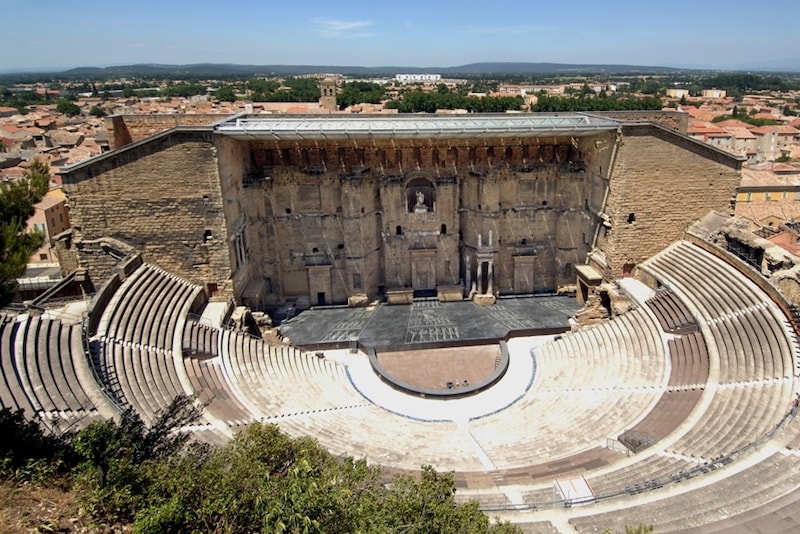 The Roman Theater at Orange, an unequalled venue for music. How the Romans must have enjoyed their performances... (Gromelle Grand Angle via CC BY-SA 3.0)
The Roman Theater at Orange, an unequalled venue for music. How the Romans must have enjoyed their performances... (Gromelle Grand Angle via CC BY-SA 3.0)To enjoy the theater at its most dazzling, you need to watch a play under the stars and you can do that each summer at the amazing outdoor Chorégies opera and classical music festival.
Curious about how a bunch of warring tribes slowly came to absorb Roman culture and civilization? Becoming Roman looks at all the social changes (food, even!) and details the process through extensive research. This is what your inner historian is clamoring for! BUY ON AMAZON
8. Vaison-la-Romaine
Half an hour's drive from Orange, in a bit of a detour towards the northeast, is Vaison-la-Romaine, the largest of the Roman sites in France, replete with baths, shop-lined streets, wealthy homes, a wonderful 6000-seat theater (still in use), statues and ceramics, much of it on show at the Théo Desplans Archeological Museum, which is crammed with everyday objects the Romans once used.
The ruins were discovered in two distinct neighbourhoods: Puyman and la Villasse, with the former being in better shape than the later.
Originally named Vasio under the Romans, the town eventually called itself Vaison, only adding La Romaine (the Roman) in 1924 after major ruins were uncovered. Those ruins cover 15 hectares of what was one of the most prosperous Roman cities in France, in the Narbonnaise province.
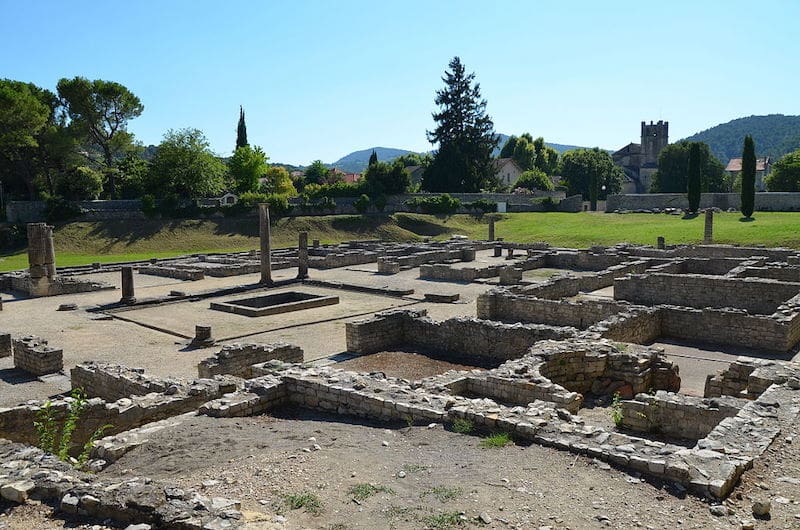 Ruins of Vasio, today's Vaison-la-Romaine (Carole Raddato from Frankfurt, Germany via CC BY-SA 2.0)
Ruins of Vasio, today's Vaison-la-Romaine (Carole Raddato from Frankfurt, Germany via CC BY-SA 2.0)9. Pont du Gard
Between Orange and Nîmes stands the Pont du Gard, a three-level structure that is, at 50m, not only the highest Roman aqueduct in France but the highest ever built – one of the most famous ruins in France, actually.
It was built halfway into the 1st century AD to supply water from the Gardon to the city of Nemausus, modern-day Nîmes, a city in southern France noted for Roman ruins.
Plenty of Pont du Gard facts confirm the importance of this aqueduct, a public utilities project designed to show off the Roman Empire’s superiority.
Some 800-1000 men worked for five years to build this magnificent structure, which was no mean feat: blocks of limestone, some weighing up to six tons, were brought in from the Estel quarry 600 meters away, using only using picks and other sharp metal objects.
A complex scaffolding system supported the structure while workers positioned the blocks, and some scaffolding ridges and supports are still visible on the aqueduct's façade.
What is perhaps most impressive is the lack of mortar – the stones were cut so precisely that none was needed to fit them together.
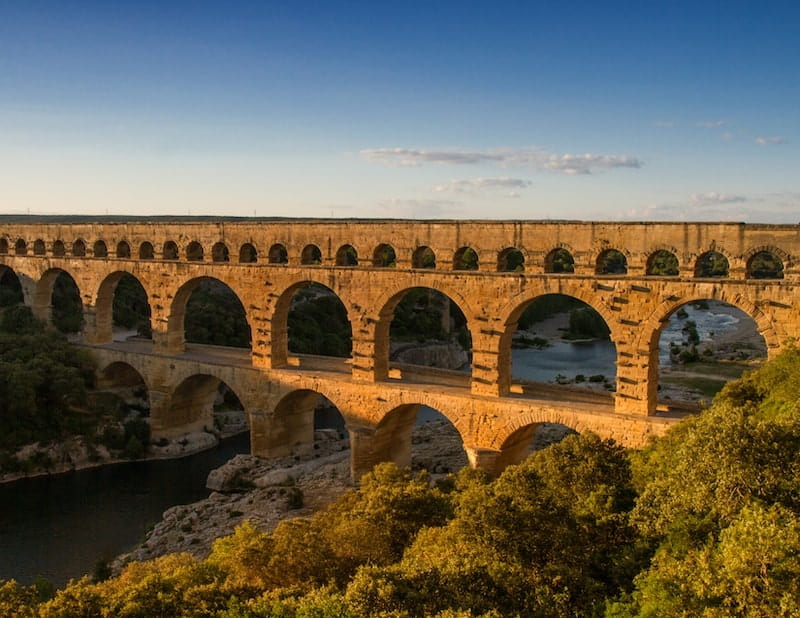 The Pont du Gard, Provence, is the highest of Roman aqueducts (France) and a remarkable remnant of France in Roman times
The Pont du Gard, Provence, is the highest of Roman aqueducts (France) and a remarkable remnant of France in Roman timesThis technical marvel has stood the test of time and is one of the best-preserved Roman aqueducts in France, or anywhere. It is protected as a UNESCO World Heritage Site.
Ally of Ally Travels visited and tells us that at the Pont du Gard, you will also find a museum, restaurant, and swimming in the Gardon just upstream from the aqueduct. The site is open year-round and even features a light show during the summer months (if you like that sort of thing – I'm afraid I'm a child at heart and absolutely do!)
10. Arènes de Nîmes Roman ruins
Heading southward we shortly reach Nîmes, an important Roman city first settled by legionnaires who had fought in Egypt and received land here as a reward for their bravery in battle.
Built like a typical Roman city with two perpendicular main streets, all monuments and main buildings were positioned where the two streets crossed each another.
In its early days, Nîmes was classically Roman: locals spoke Latin, men wore togas and women sought out the latest fashions from Rome.
Spectators would gather in the arena to watch gladiators do battle, wild animals fight to the death and even witness the occasional public execution. The arena could accommodate up to 24,000 people.
With its nearly 2000 years of history, the impressive Nîmes Arena is the best-preserved Roman amphitheater in the world. It was built around 100AD, not long after the Colosseum in Rome.
During the Middle Ages, it was transformed into a fortress to protect the city's inhabitants in case of danger, sheltering a fortified village with houses, shops and churches. The village was destroyed in 1809 and the Roman amphitheater restored to what we know today.
Nîmes is ideally situated along any southern France road trip itinerary and is really worth the detour if you're a fan of Rome and Ancient History, along with other ruins nearby.
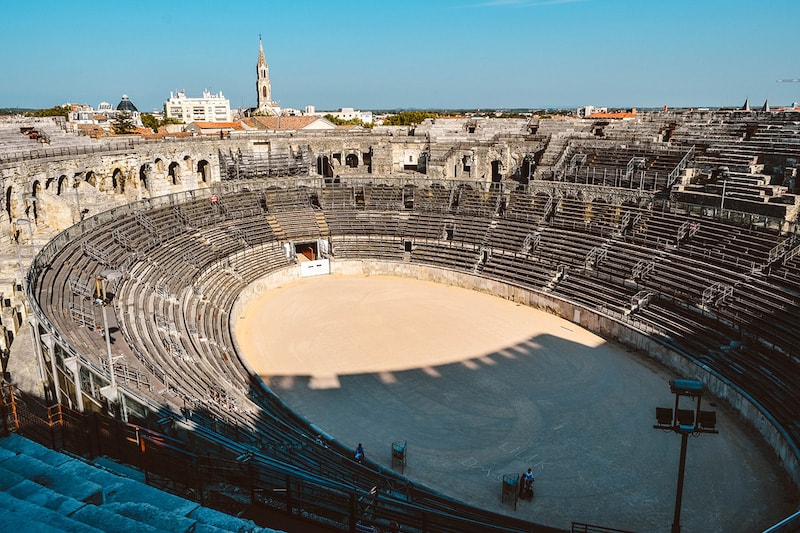 The arena of Nîmes, France, representative of Gaul in Roman times
The arena of Nîmes, France, representative of Gaul in Roman timesAnn Kelly, who publishes The Road is Life blog, says that while in Nîmes you should also visit the Maison Carrée, or square house, a distinctive Roman temple dating back to the year 2 AD (and in fact the only perfectly preserved Roman temple).
"Don't miss out on a breathtaking view over the city from La Tour Magne, a Roman tower that was once part of the original 6km wall which protected the ancient city," she adds.
To relive Nîmes as it was in Antiquity and to revel in the more than 5000 pieces recovered from the ancient France city, visit the Musée de la Romanité, which I thoroughly enjoyed and you shouldn't miss, just across from the amphitheater. Click here if you need to book a hotel in Nîmes.
AMPHITHEATER? ARENA? IS THERE A DIFFERENCE?
Yes and no. (Don't you hate that?)
Depending on what you read, an amphiteater could be a semi-circle where people gathered for a performance. On the other hand, an arena would be an oval, enclosed area, usually with a sandy floor, used for such things as sports events. BUT - these distinctions go out the window when you apply the definitions to Ancient History, which seems to treat both as the same... So I've used them interchangeably (and probably incorrectly).
11. Arènes d'Arles (Amphitheater)
A mere 45 minutes' drive to the south is Arles, another French city noted for Roman remains and which gives Nîmes a run for its money.
The Arles arena has space for 20,000 spectators, and gladiators fought here until the very end of the Roman Empire in France.
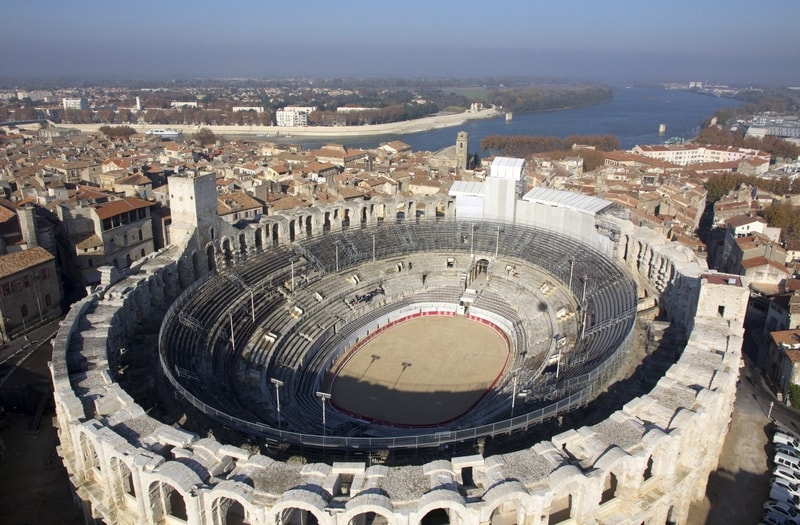 The stunning arena of Arles (Paul-Louis Fernandez de la société MEROPS-Photo via CC BY 3.0)
The stunning arena of Arles (Paul-Louis Fernandez de la société MEROPS-Photo via CC BY 3.0)Located at the crossroads between Italy and Spain, Arles occupied a strategic position in the Roman Empire.
At one point, under Emperor Constantine (he reigned during the late Roman Empire and became its first Christian emperor), it became an imperial residence.
Given its popularity, it's no surprise there are so many Arles Roman ruins – the arena, a theater, a Roman necropolis and the remains of Constantine's baths. That said, the city is small and you can easily see it all on a walking tour.
The city's Roman credentials were strengthened with the discovery in 2008 of the oldest known bust of Julius Caesar, in the nearby waters of the River Rhône.
Consider using Arles as your base for the region and book a hotel in the city, because several of the ruins below are within easy driving distance. And while you're in Arles, take advantage of a later era to follow in the footsteps of Vincent van Gogh, who lived and painted here.
SPENDING THE NIGHT IN ARLES?
➽ CLICK HERE to check availability!
12. Glanum
There's every chance you've heard of the delightful town of Saint-Rémy-de-Provence, with its tree-lined streets and delicious food and Van Gogh trail. But have you heard of Glanum?
This ancient city sits on St-Rémy's outskirts and was built between the 4th and 2nd centuries BC.
It was first Greek and eventually Roman, once Julius Caesar succeeded in annexing what was then the Greek city of Marseille after a four-month siege.
Glanum prospered but in the end suffered the same fate as other Roman cities: it was invaded by Barbarians. The city was overrun around 260 AD, many of its buildings destroyed and the stones taken away for use as building materials.
Not everything was razed, thankfully, and what is left is absolutely worth seeing: the triumphal arch of Glanum, the Julian Mausoleum, forum remains, public baths and several temples.
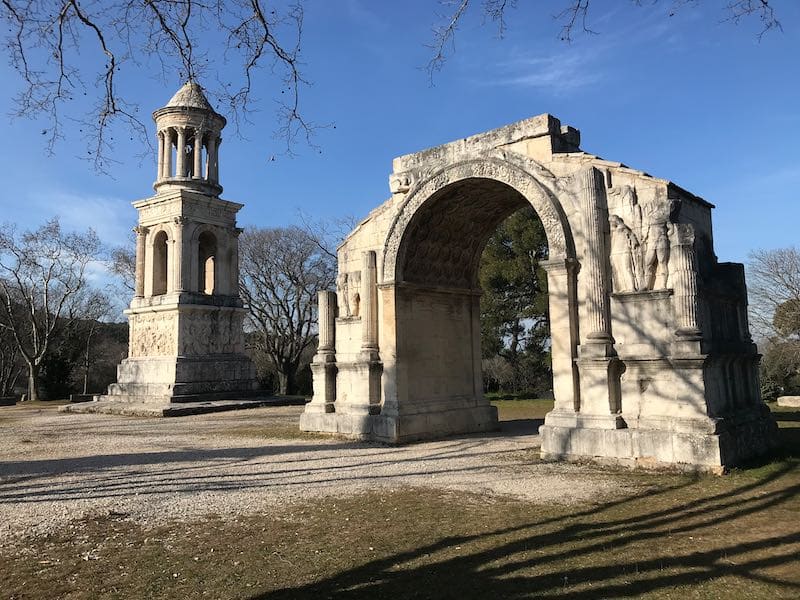 Two amazing remnants... the Mausoleum on the left, that comes to us almost intact (except for a missing pine cone at the top), and the Municipal Arch, which marked the entrance to Glanum, once a Gallic town but eventually Romanized
Two amazing remnants... the Mausoleum on the left, that comes to us almost intact (except for a missing pine cone at the top), and the Municipal Arch, which marked the entrance to Glanum, once a Gallic town but eventually Romanized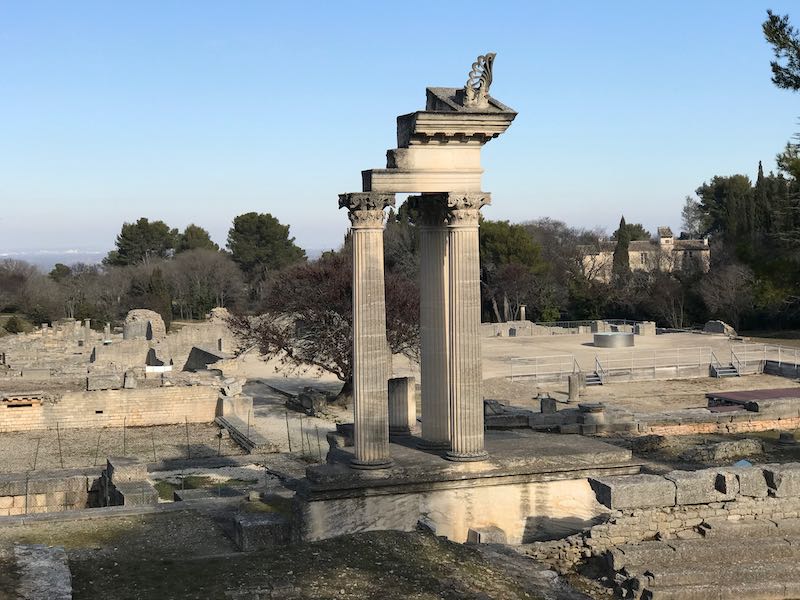 All that is left of two majestic Roman temples that stood in the center of Glanum. The remnants were found scattered and were rebuilt to look like the original
All that is left of two majestic Roman temples that stood in the center of Glanum. The remnants were found scattered and were rebuilt to look like the originalAccording to Nadine Maffre of Le Long Weekend, the best time to visit is spring, when the trees are in blossom.
"Make a day of it, and discover nearby Les Baux de Provence with its ruined château and charming village," she suggests, "or take a hike in the wild and rugged Alpilles mountains to appreciate why the Romans chose to settle in such a spot." Or take a tour of the region, like this one, which includes many of the area's most imposing sights.
13. Les Baux-de-Provence
Les Baux, in Provence, is a lovely walled village tucked into a rocky outcropping in the Apille Mountains.
With its scenic castle above the tiny town, Les Baux is one of the prettiest towns in Provence (as well as on the list of most beautiful villages of France).
While traces of civilization dating as far back as 6000 BC have been found here, the fortress wasn’t built until the Middle Ages.
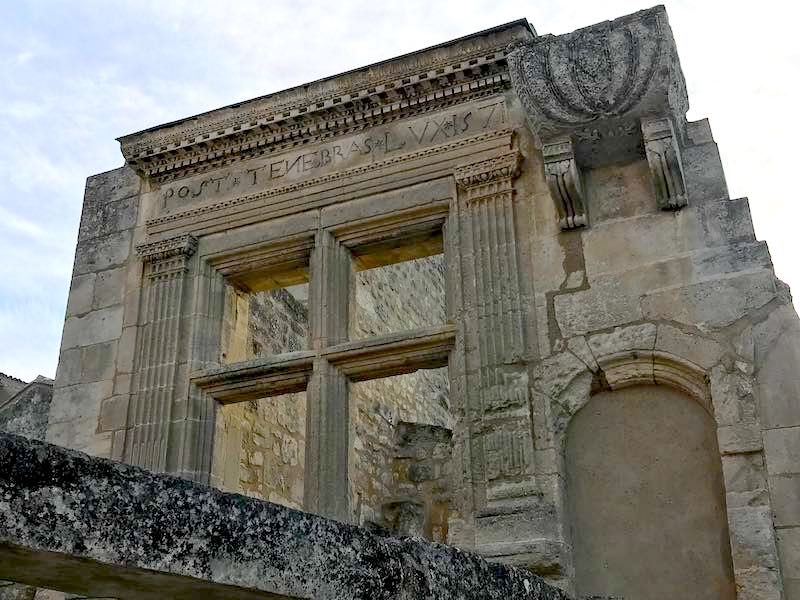 A few Roman ruins still stand in Les Baux de Provence, France
A few Roman ruins still stand in Les Baux de Provence, FranceChris Román of Explore Now or Never tells us there are many incredible Roman vestiges from the years in between, including a window with an inscription that translates into “Light after Darkness.”
It somehow seems appropriate that just beneath the fortress, in the velvety darkness of a former stone quarry, visitors now gather for one of the most popular light shows in France, Les Carrières de Lumières.
Just below the medieval village, you'll also find Les Trémaïé, pronounced tray-mah-YAY, a bas-relief carved in limestone that depicts a man and two women in Roman clothing.
Archaeologists are still trying to decide who they were. Some say they were a Roman Consul, his wife, and a Syrian prophetess. Christians believe they are the “Three Marys,” followers of Christ. Despite the disagreement, an epitaph confirms this as a Gallo-Roman votive relief.
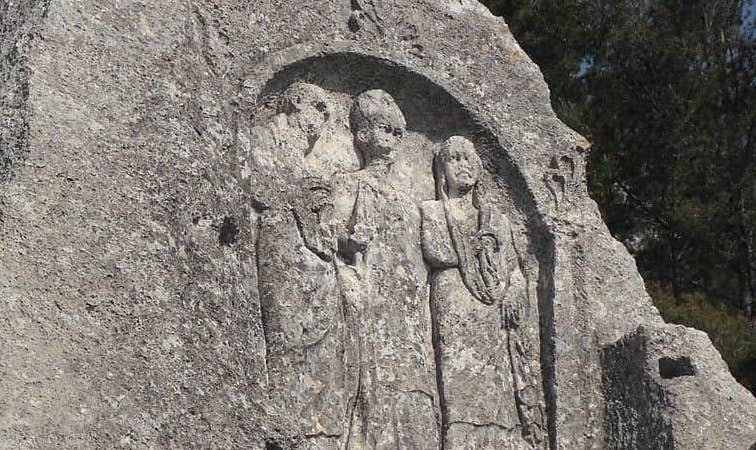 Les Trémaïé of Les Baux (Malost via CC BY-SA 3.0)
Les Trémaïé of Les Baux (Malost via CC BY-SA 3.0)Elsewhere in France
14. The Palais Gallien, Bordeaux
Bordeaux may be famous for its fine wine but the Bordelais had been producing and drinking wine long before the historic 1855 Classification that essentially put Bordeaux wines on the map.
In fact, grapes have been cultivated and wine produced in and around Bordeaux since Roman times.
The city was once known as Burdigala, and served as the capital of the Roman province of Aquitaine.
Though the grapes are long gone, the ruins of the Palais Gallien Roman amphitheater remain right in the center of Bordeaux.
Lonely Planet Bordeaux is the guidebook I've used for this city – clear, succinct and with plenty of up-to-date advice and things to do in Bordeaux. But get the hard copy: I find the Kindle version not very user friendly.
BUY FROM AMAZON
The amphitheater was built in the 3rd century AD and was quite large, with capacity for 17,000 spectators.
It is thought to have been built in anticipation of a visit by Emperor Caracalla (one of Rome's more bloodthirsty emperors and well known for the Rome baths that carry his name), and like Rome's Colosseum, gladiator games were held there.
The amphitheater was sacked by the Franks of Gaul and may have burned for two solid days, after which it was abandoned. It would take centuries before taking measures to protect it.
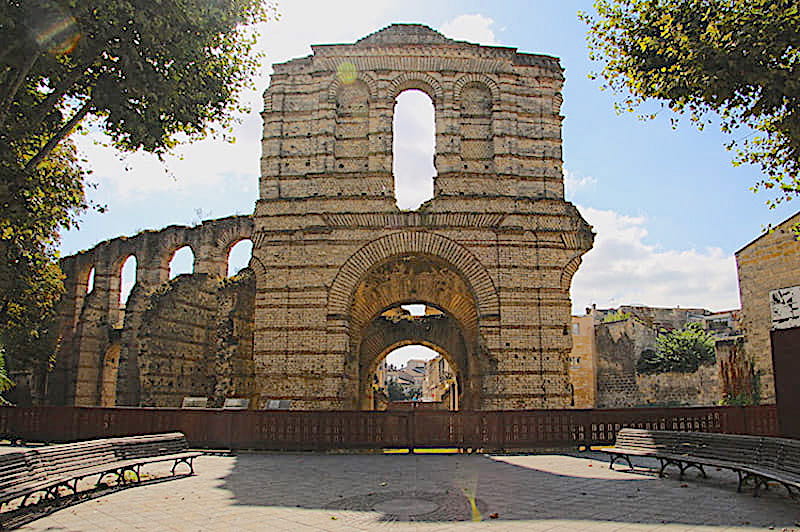 The Palais Gallien in Bordeaux, once the site of vineyards
The Palais Gallien in Bordeaux, once the site of vineyardsYou can easily walk to the Palais Gallien in 15 minutes from Bordeaux's Grand Theatre and in summer, you can book a tour through the Bordeaux Tourism Office.
Jennifer Dombrowski of the Bordeaux Travel Guide tells us this is one of the must-see free attractions in Bordeaux, which you can view from the platform on the Rue du Colisée. Bordeaux is a fabulous city with much to do − consider spending a few days to visit the region while you're here.
NEED A HOTEL IN BORDEAUX?
➽ CLICK HERE to check availability!
15. The Arch of Germanicus
In Saintes, a little to the north of Bordeaux, you'll find the remnants of another Roman amphitheater in France as well as the Arch of Germanicus, marking the entrance to town.
Mediolanum Santonum, as Saintes was once called, was the first capital of the Roman province of Aquitaine.
The arch, built in 19 AD, was dedicated to Emperor Tiberius, his son Drusus and his nephew Germanicus. The arch eventually took on the nephew's name – it was the best preserved, and most legible of the three. It's not difficult to imagine it in perfect shape...
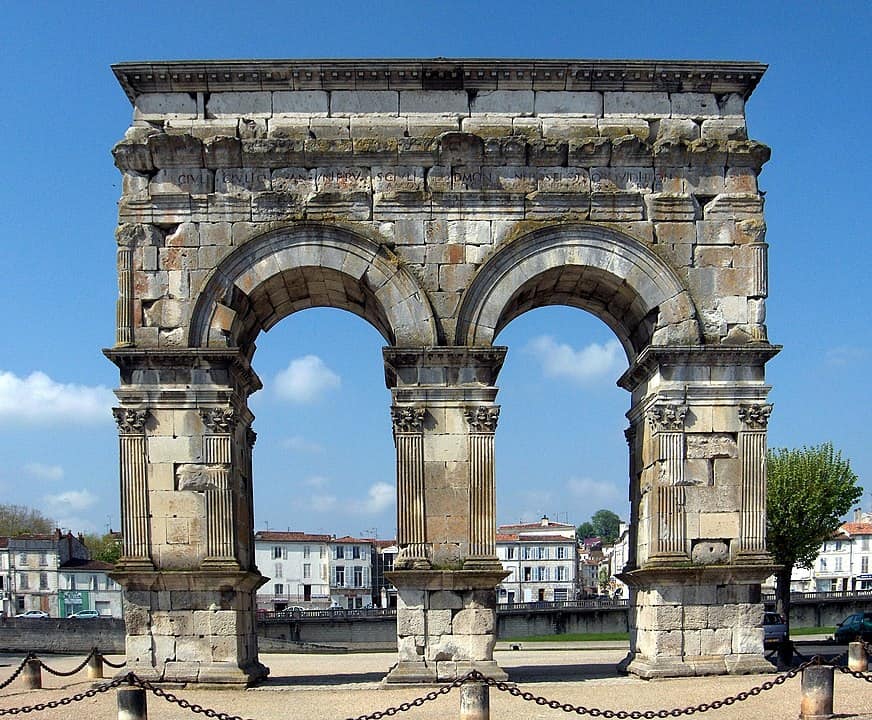
IF YOU NEED TO RENT A CAR IN FRANCE
Don't wait until the last minute, especially if you want one of the scarcer automatics.
🚗 Check availability at Discover Cars (it's what I use to compare prices).
FAQ about Romans in France
When were the Romans in France?
The conquest began around 121 BC but was completed when Julius Caesar won the Gallic Wars against Celtic tribes from 58-51 BC. Rome was eventually defeated by the Franks at the Battle of Soissons in 486 AD.
How long were the Romans in France for?
The Romans remained in France for about 600 years.
Did the Romans conquer France?
Yes they did, eventually dividing Gaul into several provinces: Gallia Transalpina (beyond the Alps), Gallia Narbonensis (the south) and Gallia Comata (the farther reaches, an arc stretching from Aquitaine to Belgium down to Switzerland).
Did you enjoy this article? I'd love if you shared it!
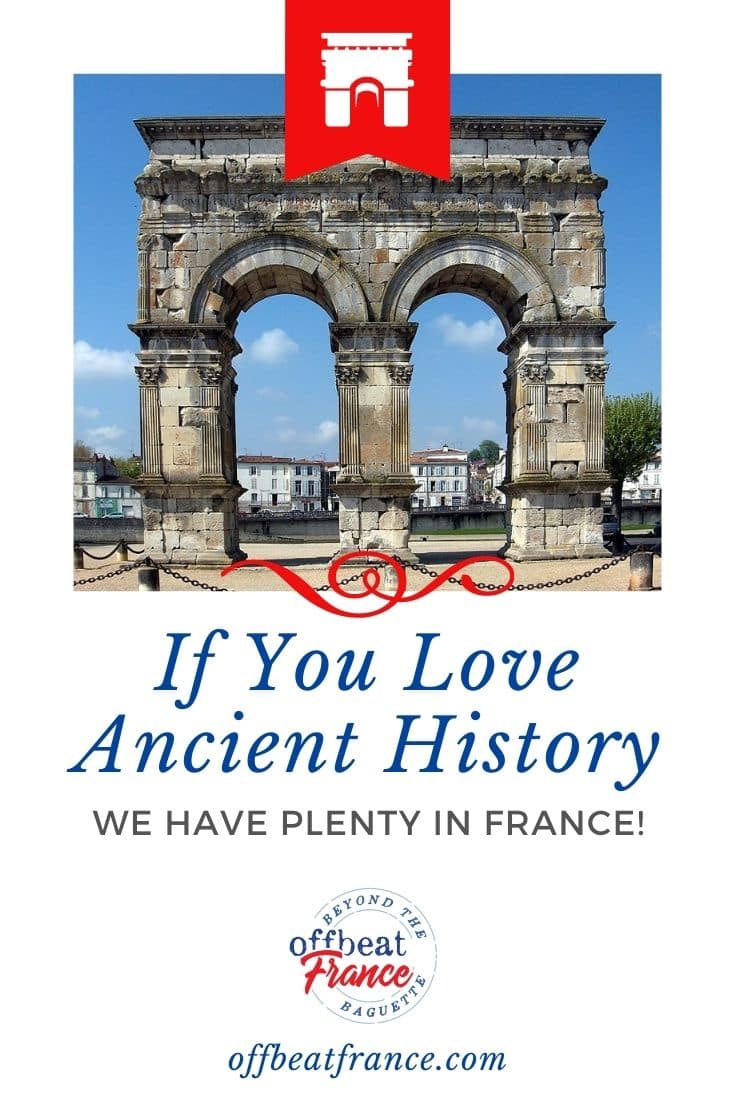 |
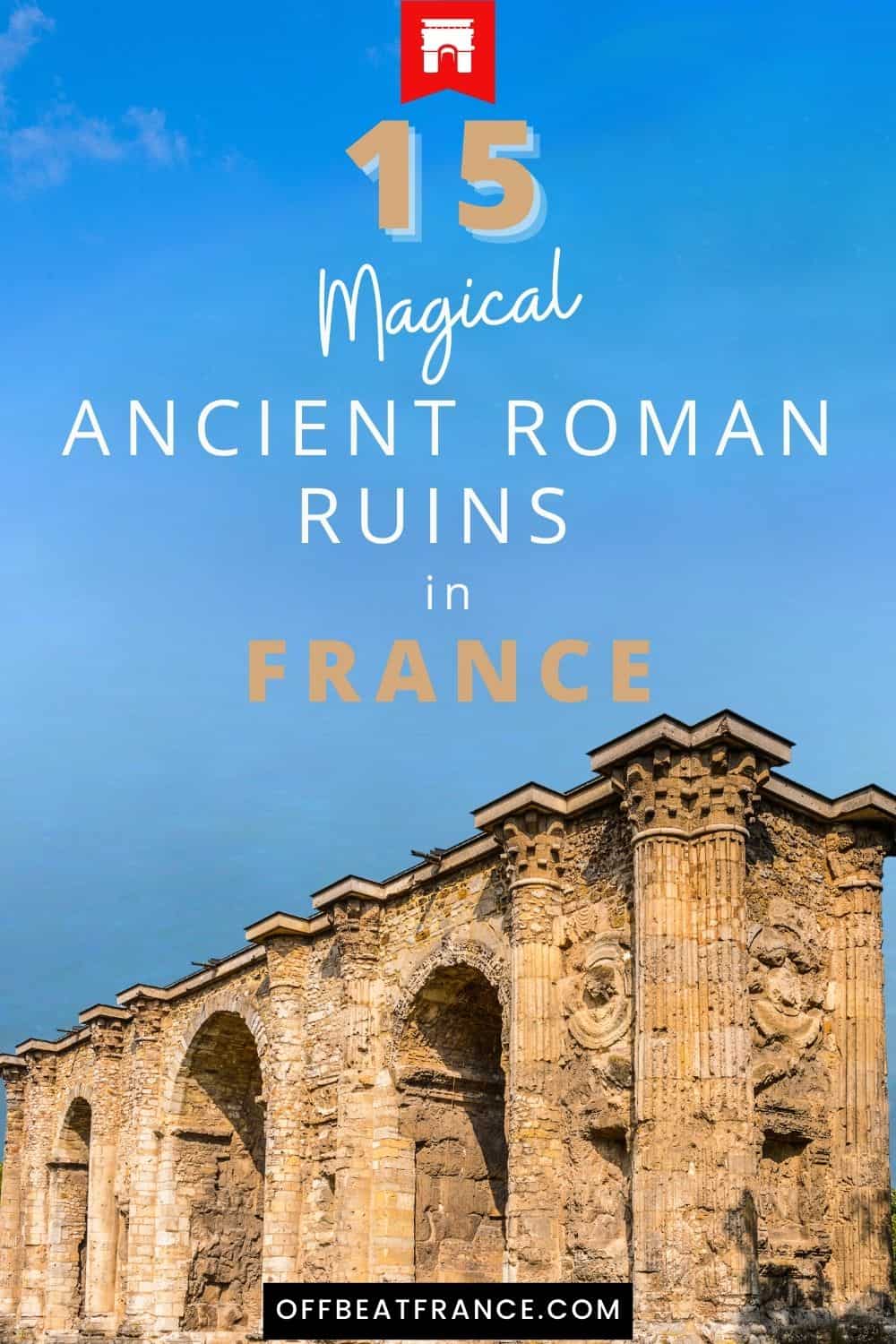 |
Pin these and save for later!


